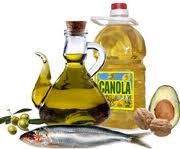 Fats: What are they??
Fats occur naturally in food and play an important role in nutrition. Fats and oils provide a concentrated source of energy for the body. Fats provide 9 calories per gram, more than two times the calories you get from carbohydrates and protein. Fats are used to store energy in the body, insulate body tissues, and transport fat soluble vitamins through the blood. They also play in important role in food preparation by enhancing food flavor, adding mouth-feel, making baked products tender, and conducting heat during cooking.
Oils are fats that are liquid at room temperature, like the vegetable oils used in cooking. Oils come from many different plants and from fish. Some common oils are:
Fats: What are they??
Fats occur naturally in food and play an important role in nutrition. Fats and oils provide a concentrated source of energy for the body. Fats provide 9 calories per gram, more than two times the calories you get from carbohydrates and protein. Fats are used to store energy in the body, insulate body tissues, and transport fat soluble vitamins through the blood. They also play in important role in food preparation by enhancing food flavor, adding mouth-feel, making baked products tender, and conducting heat during cooking.
Oils are fats that are liquid at room temperature, like the vegetable oils used in cooking. Oils come from many different plants and from fish. Some common oils are:
- canola oil
- corn oil
- cottonseed oil
- olive oil
- safflower oil
- soybean oil
- sunflower oil
- butter
- beef fat (tallow, suet)
- chicken fat
- pork fat (lard)
- shortening
- Saturated Fatty Acids are found in animal sources such as meat and poultry, whole or reduced-fat milk, and butter. Also, some vegetable oils like coconut, palm kernel oil, and palm oil contain saturated fats. Saturated fats are usually solid at room temperature.
- Monounsaturated Fatty Acids are found mainly in vegetable oils such as canola, olive, and peanut oils. They are liquid at room temperature.
- Polyunsaturated Fatty Acids are found mainly in vegetable oils such as safflower, sunflower, corn, flaxseed, and canola oils. Polyunsaturated fats are also the main fats found in seafood. They are liquid or soft at room temperature. Specific polyunsaturated fatty acids, such as linoleic acid and alpha-linolenic acid, are called essential fatty acids. They are necessary for cell structure and making hormones. Essential fatty acids must be obtained from foods we choose.
- Trans Fatty Acids are formed when vegetable oils are processed into margarine or shortening. Sources of trans fats in the diet include snack foods and baked goods made with “partially hydrogenated oil” or “vegetable shortening.” Trans fatty acids also occur naturally in some animal products such as dairy products. *Avoid or limit products containing these oils.
What is the correct serving or portion size for one fat?
| High Monounsaturated Fats (choose most often) | High Polyunsaturated Fats (choose more often) |
| 1/8 avocado | 1 tsp stick or tub margarine |
| 1 tsp olive, canola, peanut oils | 1 Tbsp reduced fat, light or nonfat margarine |
| 8 large black or green olives, stuffed | 1 tsp mayonnaise |
| ½ oz most nuts | 1 Tbsp reduced fat mayonnaise |
| 2 tsp tahini paste | 4 English walnut halves |
| 4 pecan halves | 1 tsp corn, soybean, safflower, sunflower oil |
| 1 Tbsp sesame seeds | 1 Tbsp salad dressing |
| 2 Tbsp reduced fat salad dressing | |
| 1 Tbsp pumpkin or sunflower | |
| High Saturated Fats (choose least often, if at all) | High Trans Fats (choose rarely if ever) |
| 2 tsp whipped butter | Fried Foods |
| 1 slice bacon | Commercially baked goods containing hydrogenated or partially hydrogenated oils (e.g. shortening, partially hydrogenated soybean oil) |
| 2 Tbsp boiled chitterlings | |
| 2 Tbsp half and half | |
| 1 Tbsp cream cheese | |
| 1 Tbsp sour cream | Any foods containing the words hydrogenated or partially hydrogenated |
| 1 tsp palm, palm kernel, coconut oils | |
| 1 tsp stick butter | |
| 1 Tbsp reduced fat butter | |
| 1 tsp bacon grease | |
| 2 Tbsp coconut, sweetened or shredded | |
| 2 Tbsp cream | |
| 2 Tbsp reduced fat cream cheese | |
| 2 Tbsp reduced fat sour cream |

